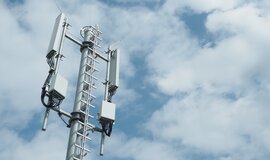
Start of a field study on innovative antenna systems for FRMCS deployments
Digitale Schiene Deutschland, Ericsson and Rohde & Schwarz are cooperating to investigate signal propagation at 1.9 GHz and multi-antenna radio technologies in a field trial project. The trials take place in DB’s Digital Rail Testbed in Erzgebirge and use spectrum which is foreseen for the Future Railway Mobile Communication System (FRMCS). Findings of the field study shall support the design and deployment of radio systems for prospective digital rail operations.
Digitale Schiene Deutschland plans to take rail operations to a new level by introducing modern technologies for enabling automation and improved railway performance. The increased grade of automation comes with new use cases and more demanding data communication needs. Data rates increase due to emerging services such as critical video and sensor information transfer. Both come on top of transmission of voice and train control data. Next generation mobile communication technologies such as 5G will be the basis for a powerful and flexible Future Railway Mobile Communication System (FRMCS). They will initially complement and eventually replace the currently running 2G based GSM-R system, which cannot meet the connectivity requirements of digital rail operations.
Advanced multi-antenna radio systems are one key element to achieve higher data rates and to substantially increase the cell range in rail communication networks. Multiple-input multiple-output (MIMO*), coordinated multi-point (CoMP*) and beamforming* are innovative antenna techniques which can be used for rail-specific radio optimization. A concept study of these techniques has already been conducted in a collaboration between Digitale Schiene Deutschland and Ericsson in 2019. In this follow-up project, the partners commit themselves now for real-world testing in DB’s Digital Rail Testbed which is located in the Erzgebirge region in Saxony, Germany. The field trials will be performed in the 1900-1910 MHz TDD frequency band which is one of the bands foreseen for the introduction of FRMCS.
As part of the planned trials, the performance of multi-antenna techniques of the mobile network infrastructure provided by Ericsson is investigated in a rail context, using expert consultancy and specialized test equipment from Rohde & Schwarz. This includes assessing different onboard antenna placement strategies on the rooftop of the test train. Test train partner is DB Technik TecLab with its “advanced TrainLab” – a diesel-electric ICE which hosts a unique connectivity platform with flexible antenna mounting options.
The field trials are one essential step of Digitale Schiene Deutschland and DB Netz towards the envisioned roll-out of a DB-owned FRMCS infrastructure which will provide the vital connectivity backbone for digitalized rail operation. Results are expected at the end of 2021. They shall allow to feedback learnings into the ongoing FRMCS standardization process, and help to tailor FRMCS radio deployments towards the specific needs of digital rail services in the future.
*Multiple-Input-Multiple-Output (MIMO) systems use multiple antennas at transmitter and receiver side for so-called “spatial multiplexing” of multiple data streams in parallel
*Beamforming allows to direct transmitted signals into a certain direction and hence increase signal quality, coverage and data rate.
*Coordinated Multi-Point (CoMP) refers to schemes where multiple trackside antennas jointly transmit and receive the signals related to one or multiple trains, which allows to improve the signal quality in particular at the edge between radio cells.